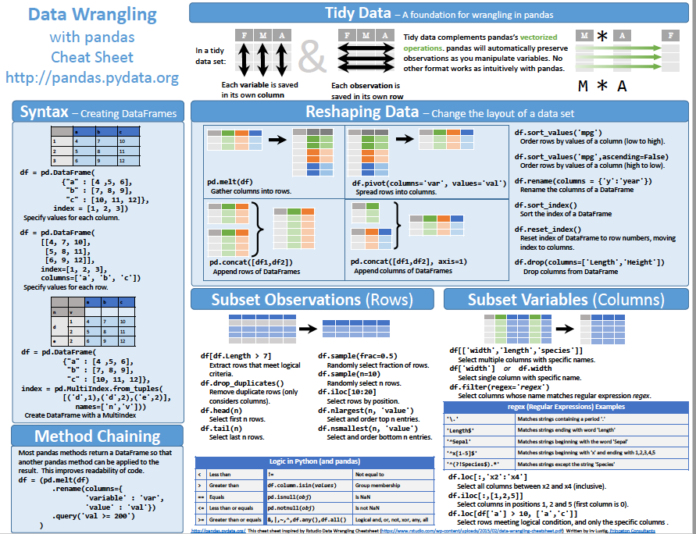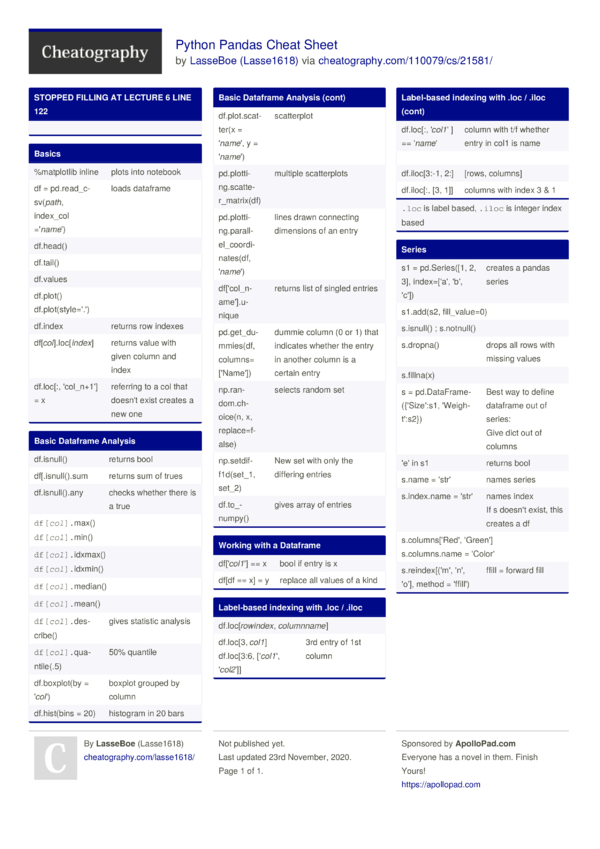The Pandas cheat sheet will guide you through some more advanced indexing techniques, DataFrame iteration, handling missing values or duplicate data, grouping and combining data, data.
Download all 8 Pandas Cheat Sheets. Learn more about the Python for Data Analysis and Pandas Mastery Workshop training courses. Pandas (the Python Data Analysis library) provides a powerful and comprehensive toolset for working with data. Fundamentally, Pandas provides a data structure, the DataFrame, that closely matches real world data, such. Pandas Cheat Sheet One of the first things that you need to do to make use of this library is importing it. What might come unnaturally to people who are just starting with Python and/or programming is the import convention. Python is the top dog when it comes to data science for now and in the foreseeable future. Knowledge of Pandas, one of its most powerful libraries is often a requirement for Data Scientists today. Use this cheat sheet as a guide in the beginning and come back to it when needed, and you’ll be well on your way to mastering the Pandas library.
Pandas can be used as the most important Python package for Data Science. It helps to provide a lot of functions that deal with the data in easier way. It's fast, flexible, and expressive data structures are designed to make real-world data analysis.
Pandas Cheat Sheet is a quick guide through the basics of Pandas that you will need to get started on wrangling your data with Python. If you want to begin your data science journey with Pandas, you can use it as a handy reference to deal with the data easily.
This cheat sheet will guide through the basics of the Pandas library from the data structure to I/O, selection, sorting and ranking, etc.
Key and Imports
My Python Pandas Cheat Sheet
We use following shorthand in the cheat sheet:
- df: Refers to any Pandas Dataframe object.
- s: Refers to any Pandas Series object. You can use the following imports to get started:
Importing Data
- pd.read_csv(filename) : It read the data from CSV file.
- pd.read_table(filename) : It is used to read the data from delimited text file.
- pd.read_excel(filename) : It read the data from an Excel file.
- pd.read_sql(query,connection _object) : It read the data from a SQL table/database.
- pd.read_json(json _string) : It read the data from a JSON formatted string, URL or file.
- pd.read_html(url) : It parses an html URL, string or the file and extract the tables to a list of dataframes.
- pd.read_clipboard() : It takes the contents of clipboard and passes it to the read_table() function.
- pd.DataFrame(dict) : From the dict, keys for the columns names, values for the data as lists.
Exporting data
- df.to_csv(filename): It writes to a CSV file.
- df.to_excel(filename): It writes to an Excel file.
- df.to_sql(table_name, connection_object): It writes to a SQL table.
- df.to_json(filename) : It write to a file in JSON format.
Create Test objects
It is useful for testing the code segments.
- pd.DataFrame(np.random.rand(7,18)): Refers to 18 columns and 7 rows of random floats.
- pd.Series(my_list): It creates a Series from an iterable my_list.
- df.index= pd.date_range('1940/1/20', periods=df.shape[0]): It adds the date index.
Viewing/Inspecting Data
Python Pandas Cheat Sheet Datacamp
- df.head(n): It returns first n rows of the DataFrame.
- df.tail(n): It returns last n rows of the DataFrame.
- df.shape: It returns number of rows and columns.
- df.info(): It returns index, Datatype, and memory information.
- s.value_counts(dropna=False): It views unique values and counts.
- df.apply(pd.Series.value_counts): It refers to the unique values and counts for all the columns.
Python Cheat Sheet Pandas Pdf
Selection
- df[col1]: It returns column with the label col as Series.
- df[[col1, col2]]: It returns columns as a new DataFrame.
- s.iloc[0]: It select by the position.
- s.loc['index_one']: It select by the index.
- df.iloc[0,:]: It returns first row.
- df.iloc[0,0]: It returns the first element of first column.
Data cleaning
- df.columns = ['a','b','c']: It rename the columns.
- pd.isnull(): It checks for the null values and returns the Boolean array.
- pd.notnull(): It is opposite of pd.isnull().
- df.dropna(): It drops all the rows that contain the null values.
- df.dropna(axis= 1): It drops all the columns that contain null values.
- df.dropna(axis=1,thresh=n): It drops all the rows that have less than n non null values.
- df.fillna(x): It replaces all null values with x.
- s.fillna(s.mean()): It replaces all the null values with the mean(the mean can be replaced with almost any function from the statistics module).
- s.astype(float): It converts the datatype of series to float.
- s.replace(1, 'one'): It replaces all the values equal to 1 with 'one'.
- s.replace([1,3],[ 'one', 'three']):It replaces all 1 with 'one' and 3 with 'three'.
- df.rename(columns=lambda x: x+1):It rename mass of the columns.
- df.rename(columns={'old_name': 'new_ name'}): It consist selective renaming.
- df.set_index('column_one'): Used for changing the index.
- df.rename(index=lambda x: x+1): It rename mass of the index.

Filter, Sort, and Groupby
- df[df[col] > 0.5]: Returns the rows where column col is greater than 0.5
- df[(df[col] > 0.5) & (df[col] < 0.7)] : Returns the rows where 0.7 > col > 0.5
- df.sort_values(col1) :It sorts the values by col1 in ascending order.
- df.sort_values(col2,ascending=False) :It sorts the values by col2 in descending order.
- df.sort_values([col1,col2],ascending=[True,False]) :It sort the values by col1 in ascending order and col2 in descending order.
- df.groupby(col1): Returns a groupby object for the values from one column.
- df.groupby([col1,col2]) :Returns a groupby object for values from multiple columns.
- df.groupby(col1)[col2]) :Returns mean of the values in col2, grouped by the values in col1.
- df.pivot_table(index=col1,values=[col2,col3],aggfunc=mean) :It creates the pivot table that groups by col1 and calculate mean of col2 and col3.
- df.groupby(col1).agg(np.mean) :It calculates the average across all the columns for every unique col1 group.
- df.apply(np.mean) :Its task is to apply the function np.mean() across each column.
- nf.apply(np.max,axis=1) :Its task is to apply the function np.max() across each row.
Join/Combine
- df1.append(df2): Its task is to add the rows in df1 to the end of df2(columns should be identical).
- pd.concat([df1, df2], axis=1): Its task is to add the columns in df1 to the end of df2(rows should be identical).
- df1.join(df2,on=col1,how='inner'): SQL-style join the columns in df1 with the columns on df2 where the rows for col have identical values, 'how' can be of 'left', 'right', 'outer', 'inner'.
Statistics
The statistics functions can be applied to a Series, which are as follows:
- df.describe(): It returns the summary statistics for the numerical columns.
- df.mean() : It returns the mean of all the columns.
- df.corr(): It returns the correlation between the columns in the dataframe.
- df.count(): It returns the count of all the non-null values in each dataframe column.
- df.max(): It returns the highest value from each of the columns.
- df.min(): It returns the lowest value from each of the columns.
- df.median(): It returns the median from each of the columns.
- df.std(): It returns the standard deviation from each of the columns.


